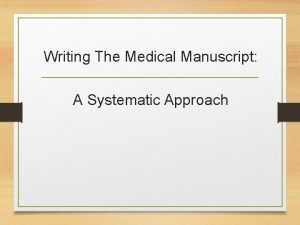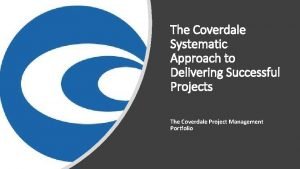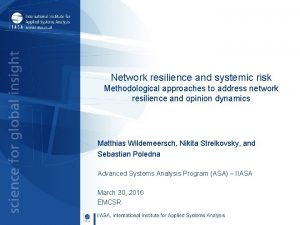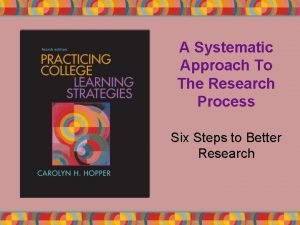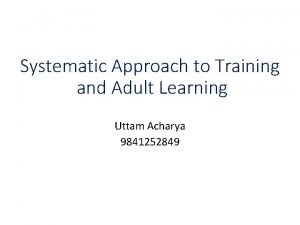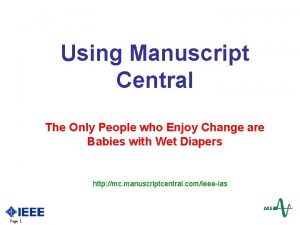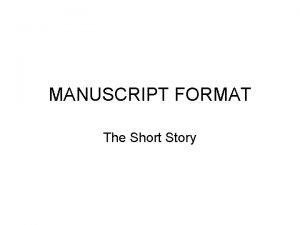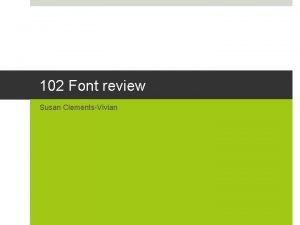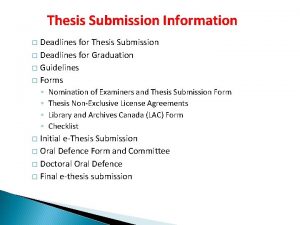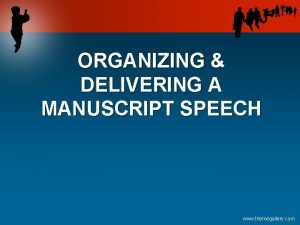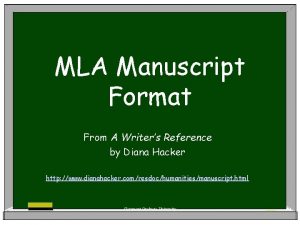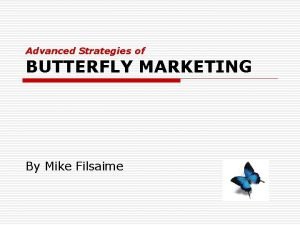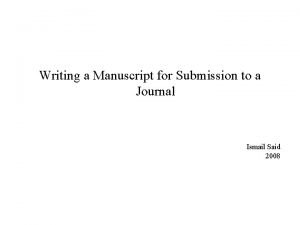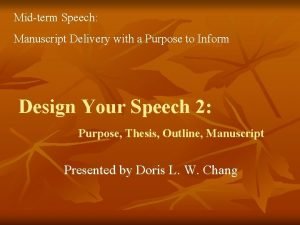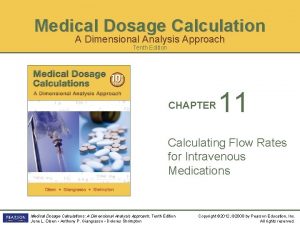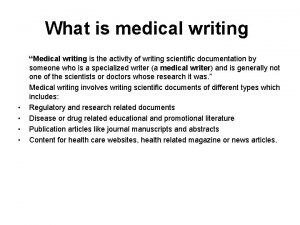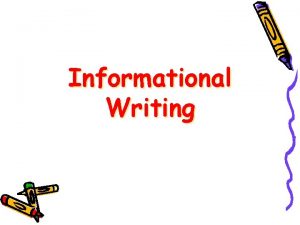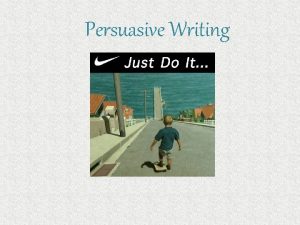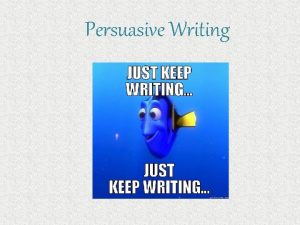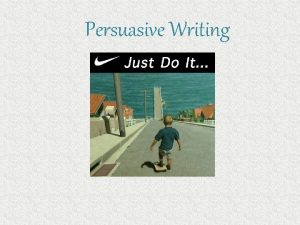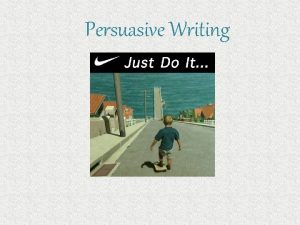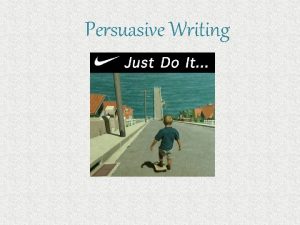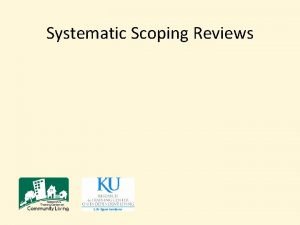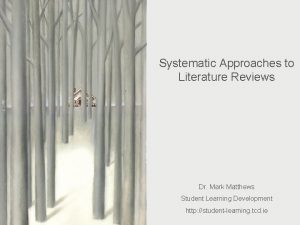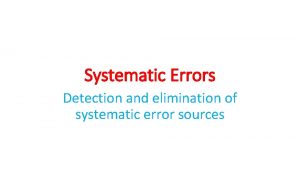Writing The Medical Manuscript A Systematic Approach Manuscript
















































- Slides: 48

Writing The Medical Manuscript: A Systematic Approach

Manuscript Writing • Part I • About writing and what makes a good paper • Parts of a manuscript • Writing strategies • Part II • Essentials of good writing • Sentences-Paragraphs • Common writing mistakes

Medical Communications Today • Medical science becoming increasing specialized • 1976: ~ 5, 000 biomedical journals, only in libraries • 2006: >17, 000 biomedical journals, electronic on internet • Subspecialties and new vocabularies has increased dramatically over past 20 years • Biomedical research moving to interdisciplinary initiatives— The NIH Roadmap • Thus, readership increasingly specialized yet interdisciplinary, requiring an approach that is common, clear, simplified. “We must strive to make our articles increasingly ‘reader friendly’ and cross-discipline in language…”

The Avoidable Downfall Your research • Carefully planned • Novel • Flawlessly designed and executed Your paper • Poorly designed and written—rejected or delayed • The loss or delay of disseminating important critical information to the science community

Journal Editors Agree • Good writing signals clear thinking and an organized approach • Clear direct English and logical, cohesive, organized writing are key to acceptance • Even the most novel and well-constructed study will be rejected if the writing is flawed

Writing is an Essential Skill • The ability to communicate clearly and precisely through the written word is an essential skill for medical researchers • Delayed publications and denial of funding because of poorly written manuscripts and grants continues to plague researchers • The career of a researcher can depend heavily on this skill

Key Difficulties • Many papers are poorly constructed and written • Some scientists have not learned good manuscript writing techniques • Others do not enjoy writing, and do not take the time or effort to ensure that the prose is clear and logical. • Authors are typically so familiar with the material that it is difficult to step back and view it from the point of view of a reader not familiar with the science • Peer review is therefore critical

Top 10 Reasons Manuscripts Rejected 1. Wrong journal, format, preparation 2. Disorganized study design 3. Defective tables, figures 4. Poor organization throughout, writing, spelling 5. No hypothesis or problem statement 6. No or insufficient conclusion 7. Overinterpretation of results 8. Article unfocused, too verbose and long 9. Inappropriate statistical methods; methods not sufficient to repeat study 10. Poorly written abstract/title Pierson DJ, Respiratory Care 49(10), 2004 Byrne DW, Publishing Medical Research Papers, Williams and Wilkins, 1998

The Paper • Writing and editing the paper is the last step in the research process • The paper tells the story from study inception, through data collection, statistical analysis, findings and discussion • The process of writing the paper should be analogous to the research process—it requires attention to detail, time, and revision

Start with Outline • Outline each segment of the paper using traditional outline: I, III, A, B, 1, 2, a • • • Forces logical thought and order Eliminates unorganized thinking and writing Uncovers flaws in arguments Reduces wordiness Makes writing easier Include your draft figures, tables

Outline I. Introduction A. Zinc plays a critical role in biochemical functions in cells 1. Mitochondrial function (Billings) 2. Cell motility (Jones, Smith) B. Zn concentrations affected by physiological changes in pregnancy (Billings) C. Zn deficiency increases spontaneous abortions and pregnancy complications 1. Rhesus monkeys (Putter) 2. White rats (Michaels, Reiss) D. In humans, the role of Zn deficiency in pregnancy outcome is unclear (Brown) E. Objective: we evaluated whether Zn supplementation during pregnancy is associated with changes in birth outcomes.

Journal Editor: What’s A Good Manuscript? Title descriptive and specific Abstract descriptive, specific, and correct length Introduction and background short and strong Research question clearly stated Literature cited is comprehensive and relevant Methods descriptive enough to be replicated; appropriate statistical analyses Figures and Tables stand on their own, support conclusions, well constructed Citations relevant to topic Discussion within boundaries of findings; demonstrate how findings have helped resolve stated problem; implications and future work addressed Writing clear, terse, logical Manuscript follows journal guidelines

The Title • First reviewed by Journal Editors before abstract • Short • Specific, Relevant, Descriptive • Write last—your findings and conclusions may alter your title

• What is the single most important point of this study? • How would I tell my colleague, in one short descriptive sentence: what’s this study about? • A descriptive, specific title perfectly framing your study will be apparent only after you’ve written the paper and abstract. • Start with a short descriptive working title

Unnecessary Title Phrases • A Study of… A Study to Determine Results of… • An Innovative Method… • Contributions to (of)… • Investigations on (concerning, about)… • Observations on… • A Trial Comparing…

Title—Specific & Descriptive • A Study Involving Medical Imaging with Genetic Patients and Turner’s Syndrome MRI Brain Imaging in Children With Turner’s Syndrome and Other X Chromosome Abnormalities • Nerve Growth Factors and Sodium Channels in Pancreatic Cells Nerve Growth Factor Increases Sodium Channel Expression in Pancreatic (Beta) Cells: Implications for Insulin Secretion

Title—Specific & Descriptive • Down Syndrome—Where we are today: A Review Down Syndrome: Genetic, Behavior, and Functional Neuroimaging Research 2000 -2006 • Aldosterone and Heart Failure Aldosterone Plasma Concentrations Increase with Severity of Congestive Heart Failure • A study of MI in older Americans 1994 -1999 Epidemiological survey of MI in Community-Dwelling American Males Over 65 years • Lazarus arise! Life and Death Issues in Intensive Care End-of-Life Care Issues for Critically Ill Patients in Intensive Care Hospitals

Title—Specific & Descriptive • Hepatitis C virus associated membranoproliferative glomerulonephritis: A tale of Mice and Men Membranoproliferative Glomerulonephritis Associated with Hepatitis C Virus in F 39(b) Nude Mice: Applicability to Humans • Isolated unilateral tubular sclerosis-associated severe late-stage renal cystic disease in neonates Severe, Late-Stage Renal Cystic Disease in Neonates Associated with Isolated Unilateral Tubular Sclerosis • Drug trial comparing systemic beta blocker with calcium-channel blocker in CHF Open-label Comparison of Altenolol and Propranolol versus Nifedipine in Patients with CHF: Beta Blocker and Calcium. Channel Blocker Mechanisms

Don’t Stack Adjectives • Female but not male serotonin reuptake transporter (5 -HTT) model knockout mice exhibit bladder instability: Implications 5 -HTT female (not male) knockout mice have unstable bladders: Implications for Stress Urinary Incontinence Treatment

Good Titles—Sentences • Intellectual impairments occur in children with blood lead concentrations above 10 mg per deciliter • Increased 17 b-estradiol suppresses PTHr. P gene expression in breast cancer cell lines • Spinal cord stimulation attenuates visceromotor reflexes in a rat model of post-inflammatory colonic hypersensitivity • Rhinovirus challenge decreases antioxidant enzymes in respiratory epithelial cells

• Not Sentences But Good Titles Comparison of MRI and CT for Detection of Acute Intracerebral Hemorrhage • Extracranial Thrombotically Active Carotid Plaque as a Risk for Ischemic Stroke • Annual Revaccination Against Influenza and Mortality Risk in Community-Dwelling Elderly Persons • Effect of Antihypertensive Agents on Cardiovascular Events in Patients With Coronary Disease and Normal Blood Pressure. The CAMELOT Study: A Randomized Controlled Trial

The Abstract • 1 st Impression to journal editor and the reader! • Follow the Journal’s Guidelines • Most abstracts are often too long: ≤ 250 words: Cannot upload your paper! • Structure it (outline it) “The abstract is the single most important part of a manuscript, yet the most often poorly written” -JAMA Editor

The Abstract • First looked at by editors/sometimes only thing read by readers • Sometimes only part available electronically—KEY words! • Summarizes the main points succinctly: • • • Background/Significance Objective Study design, method Primary germane results Principal conclusions, implications • Do NOT be vague—be substantive and brief • NOT “The implications are summarized” • INSTEAD Summarize the implications!

Abstract • Emphasize methods, main results, and conclusion • Introduction/purpose: 1 short sentence • Put objective as imperative style: • Objective: To evaluate whether zinc supplementation during pregnancy affects infant birth measures. • Methods, Results: 2 -4 sentences • Conclusion: 1 -2 sentences

Structured Abstract Context—Summarize the study rationale and provide clinical (or other) reason for the study question. Objective—State the purpose or question asked. If more than one objective, state primary objective and key secondary objectives. Design—Describe basic design, including relevant details. Setting—General community, primary care, hospital, etc. Patient or other population—describe demographics, disorders, inclusion/exclusion criteria, etc. Interventions—name, dosage Main outcome measure(s) Results Conclusions

Introduction • Why did you carry out this research? State the specific purpose or rationale for the study. • What is the existing state of knowledge of this topic? Synthesize information tracing the development of the problem and summarize its current state…ie, the background. You ask (with citations): • What’s known? • What’s unknown? • What are the gaps in knowledge this study will fill? • What are you going to do and what do you expect to find? State your hypothesis or question clearly (Objectives, Aims)

Introduction • This is a vital part of your paper—it convinces (or not) the reader whether your study: • Has merit and asks important research questions • Is focused and supported by relevant recent citations • Is ultimately important to human health and human disease • Reviewers and editors will judge the paper’s importance in the introduction. • You will better focus your introduction AFTER you construct your findings (results) and consider them (discussion). • Your research question is the most important part—in your discussion, you will address whether the question or hypothesis was answered based on your data.

Methods are Critical: Editors’ Responses What section contains the most flaws? What section responsible for outright rejection? Discussion Results Methods Introduction 0 5 Discussion Results Methods Introduction 10 15 20 % Responses 0 5 10 15 20 % Responses How frequently do Editors encounter manuscript problems? Poorly written, excessive jargon Inadequate/inappropriate presentation Poor description of design Excessive zeal and self promotion Rationale confused, contradictory Essential data omitted, ignored Boring Important work of others ignored Seldom Byrne DW, Publishing Medical Research Papers, Williams and Wilkins, 1998 Occasionally Frequently

Methods n Editors judge the study on whether your methods are adequate to answer your specific aim or hypothesis Rationale for choosing procedures/tests n The pivotal point to judge whether the results are valid n § n Don’t suggest a method you have no expertise with n. Your peer reviewer may uncover this n. Use consultants for methods you have no experience with, stating this in paper Methods usually the weakest section Often deficient in detail, not providing enough information to replicate the study n Statistical shortcomings n

Methods • Study design or analysis type and period of study • Condition or disease studied • Human subjects approval • Details of sample (number, recruiting methods of study subjects, patients, how organized) • Interventions, outcome measures, statistical analyses • Include the locations and times that data were collected • Give enough information to replicate the study; don’t assume only the specialist in your field will read it

Methods • Balance between brevity and completeness • Sometimes reference an often-used method • Use figures and tables (eg, flow diagram) • Naming things—be consistent • Acronyms—spell out first time, use consistently throughout • Specialized tests, terms—use identical name in text, figs, tables • Develop list of frequently used terms • Present in logical order and your subsequent results should follow that same order

Method—Procedures Method diagrams communicate schedule of procedures, enrollment, study design, mechanisms of action, guidelines, algorithms to reduce text and increase comprehension.

Results—The Beginning • The heart of your paper • Write after figures and tables are constructed • Consider your data critically • Construct tables, figures and include them in outline • Write the results • Use subheadings • Results determine • Whether you’ve answered your original question(s) • Your direction for future studies • Both of which belong in the discussion

Results—The Beginning • State ALL the findings • • • Whether significant or not Without bias or interpretation Do not include weaknesses, strengths of study, ie don’t discuss results • List experiments in order listed in methods • Use logical headers and group your findings • • • Characteristics of study subjects Findings in order listed in methods General to specific • Use past tense • Results confirm or reject your hypothesis: they do not prove anything.

Results • Short and to the point—Main or most important findings first • Present only data directly relevant to the study—focus • Don’t repeat methods but you may remind the reader briefly how you measured something. • Allow the data to speak for itself—use tables/figures —construct them first and use as a basis for writing • In Tables and Figures, be descriptive, specific. Do not repeat the obvious: • NO: Results of the kidney lead analysis are shown in Table 1. • YES: Kidney lead concentrations increased in group 1 over the first 10 study weeks (Table 1). • Present absolute numbers and percentages so reviewers can judge the significance of the findings. • Statistical significance ≠ clinical significance

Results—Major Mistakes • Failure to provide all the data critical to answering the research question • Interpreting or commenting on results • “Six of the 20 patients required intubation, illustrating the seriousness of this problem” (belongs in Discussion) • “Over 40% of treated rats exhibited a decreased inflammatory response, an unexpected finding” (belongs in Discussion) • Failure to adequately address statistical methods • Tables and figures inappropriate, unbalanced • Tables and figures poorly constructed

Discussion Construction • Summarize major findings— 1 st paragraph • Explain how your findings relate to those of others—what do they mean? • Clinical relevance of the findings? • Limitations and how this influenced your study? • How will you overcome these in the next studies? • Explain the implications of findings • What future direction(s) will you take?

Discussion: Getting Carried Away • Few studies make discoveries changing the course of scientific direction, and so authors: • Attempt to overly state or the importance of their findings • Come to erroneous or unsupported conclusions • Uncritically accept statistical results • This all distracts from work’s importance and signals to the reviewer problems with the research • Also results in excessive length, a common problem • Authors should let the data speak for themselves

1. Discussion—Common Mistakes Unwarranted speculations 2. Injecting tangential issues 3. Conclusions not supported by the data 4. Not suggesting future directions for research hypothesis Ôstudy Ôdata/results Ôconclusions TIGHT PACKAGE

Sections Unbalanced Article 3650 words

From The Journal Editor’s Perspective

Prepare Your Manuscript Carefully • Incorrect style irritates reviewers and editors, and the wrong style suggests that another journal previously rejected the paper. • Edit carefully • Eliminate spelling, punctuation, and grammar errors • Good writing requires rewriting • Check accuracy of references with original sources • Incorrect citations inconvenience the publisher and are a disservice to the reader • Double-check numerical data! • Numbers in abstract, text, tables, figures, ledends, and text must be consistent and correct

Avoid Repetition • Do not disclose results in introduction • Do not repeat the Introduction in Discussion • In text • Do not repeat figure legends, table titles, or contents of the tables themselves • Use tables sparingly • • Presenting a few facts in text takes less space than a table Do not use tables for presenting simple lists • Abbreviations, definitions, symbols in figures and tables must be explained in legends and footnotes • Never refer a reader back to text for such information

Journal Review § Full review and decision takes ~1 month § Editors make decision based on arguments; they don’t count votes from Peer Reviewers § Most papers undergo 2 rounds before publication § For borderline decisions, a goal is to avoid multiple rounds of review § Pressure to publish quickly may lead to rejection if further experiments are needed

What Helps or Hinders the Paper? What Helps? § § § New data — to a point Referee or Editor made factual errors (easy to prove) Careful and accurate response to criticisms (table) Telling the editor that reviews were helpful in improving the paper Knowing how to submit to the journal electronically — Practice! What Doesn’t? § § Referees were “unfair” and the criticisms were largely “not valid” Guesses at referee identity followed by personal attacks Specific evidence of bias by referee (difficult to prove) Endorsements or (positive) statements about your standing and reputation

My Suggestions • Put the manuscript away for a couple of days • Read troublesome areas aloud • Don’t try to edit a mangled paragraph—delete and rewrite it • Your colleagues reviews of writing and table/figures are valuable—don’t be defensive about edits • Let go of “academic” writing habits and don’t imitate others’ writing. Develop your own clear, direct style

Writing Deficiencies Most commonly cited by journal editors • Wordiness and n Cut, condense, combine n Outline to catch logic problems • Poor flow of ideas n Consult an editor • Poor syntax and grammar n Be specific and descriptive • Excessive abstraction n Keep it simple and direct n Do not overly compress writing n Qualify statements as necessary redundancies • Unnecessary complexity • Excessive compression Byrne, D. Science Editor 23: 2, 2000 • Unnecessary qualification

Summary § Outline your paper § Start early as your data is being analyzed § Look at your data and decide how to organize and present your results: tables, figures, text § Patterns and clues will emerge to guide your argument § Start with results then introduction and discussion/conclusions § Write title and abstract last § Put it away, re-read, give to your colleagues to read § Revise, revise, and re-revise § Adhere to journal guidelines! § Critically evaluate your paper with an editor’s eye § Write clearly, logically, and simply!
 Medical manuscript writing
Medical manuscript writing Coverdale systematic approach first step
Coverdale systematic approach first step A logical systematic procedure for solving a problem
A logical systematic procedure for solving a problem Network resilience a systematic approach
Network resilience a systematic approach Systematic name
Systematic name Systematic approach to research
Systematic approach to research For adult
For adult Ias manuscript central
Ias manuscript central Manuscript format short story
Manuscript format short story Susan clements-vivian
Susan clements-vivian Preface in thesis
Preface in thesis Organizing and delivering an entertainment speech
Organizing and delivering an entertainment speech A writers reference
A writers reference Manuscript delivery.
Manuscript delivery. Endnote manuscript matcher
Endnote manuscript matcher Naskhah tulisan tangan dipanggil sebagai
Naskhah tulisan tangan dipanggil sebagai Mike filsaime
Mike filsaime Manuscript speech
Manuscript speech Nnn speech
Nnn speech Manuscript speech
Manuscript speech Datagram network vs virtual circuit network
Datagram network vs virtual circuit network Theoretical models of counseling
Theoretical models of counseling Fine grained screening
Fine grained screening Multiple approach-avoidance
Multiple approach-avoidance Cognitive approach vs behavioral approach
Cognitive approach vs behavioral approach Research approach meaning
Research approach meaning Traditional approach vs object oriented approach
Traditional approach vs object oriented approach Deep learning approach and surface learning approach
Deep learning approach and surface learning approach Medical dosage calculations a dimensional analysis approach
Medical dosage calculations a dimensional analysis approach Hát kết hợp bộ gõ cơ thể
Hát kết hợp bộ gõ cơ thể Slidetodoc
Slidetodoc Bổ thể
Bổ thể Tỉ lệ cơ thể trẻ em
Tỉ lệ cơ thể trẻ em Voi kéo gỗ như thế nào
Voi kéo gỗ như thế nào Chụp phim tư thế worms-breton
Chụp phim tư thế worms-breton Chúa yêu trần thế alleluia
Chúa yêu trần thế alleluia Các môn thể thao bắt đầu bằng tiếng bóng
Các môn thể thao bắt đầu bằng tiếng bóng Thế nào là hệ số cao nhất
Thế nào là hệ số cao nhất Các châu lục và đại dương trên thế giới
Các châu lục và đại dương trên thế giới Công của trọng lực
Công của trọng lực Trời xanh đây là của chúng ta thể thơ
Trời xanh đây là của chúng ta thể thơ Cách giải mật thư tọa độ
Cách giải mật thư tọa độ Phép trừ bù
Phép trừ bù độ dài liên kết
độ dài liên kết Các châu lục và đại dương trên thế giới
Các châu lục và đại dương trên thế giới Thể thơ truyền thống
Thể thơ truyền thống Quá trình desamine hóa có thể tạo ra
Quá trình desamine hóa có thể tạo ra Một số thể thơ truyền thống
Một số thể thơ truyền thống Cái miệng nó xinh thế chỉ nói điều hay thôi
Cái miệng nó xinh thế chỉ nói điều hay thôi
